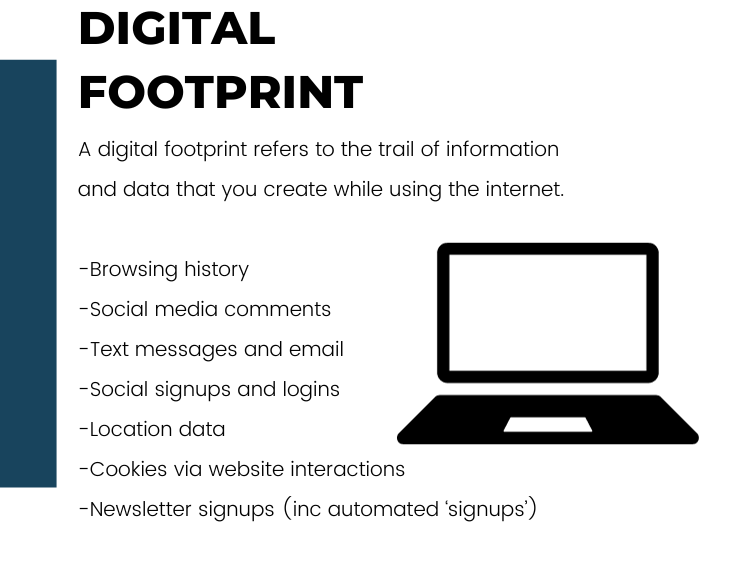The Definition Of A Digital Footprint
by TeachThought Staff
Simply put, a digital footprint is the record or trail left by the things you do online.
In the 2010s, this was a novel concept and seems woefully out of date. Google search was incredibly popular but not entirely as ubiquitous as it is today.
Previously, your social media activity, the info on your personal website, your browsing history, your online subscriptions, any photo galleries and videos you’ve uploaded–essentially, anything on the Internet with your name on it.
Today, many students don’t think twice about putting their names on things online, so their footprints can be pretty wide.
An updated definition of digital prints now includes new details like advanced algorithms, big data, new privacy laws, and cookieless browsing.
How Digital Footprints Have Changed
Over the past decade, the concept of a ‘digital footprint’ has evolved significantly due to rapid technological advancements and changes in online behavior. Initially, a digital footprint primarily referred to the traces individuals left behind while browsing the internet—such as cookies, search history, and website visits.
However, with the proliferation of social media platforms, a ‘digital footprint’ has expanded to encompass a broader scope. It now includes online activities and the vast amount of personal data generated and shared through social media posts, messaging apps, location tracking, and online transactions. This has heightened concerns about privacy, data security, and the possibility of misuse of personal information.
See also What Is The Internet Of Things?
Additionally, the notion of a digital footprint has gained prominence in various aspects of life, from education and employment to personal branding and reputation management. Employers, for instance, increasingly scrutinize applicants’ online profiles, and educational institutions may assess students’ digital presence as part of the admissions process.
As a result, people–educators, students, and parents–have needed to be more proactive in managing their online identities by using privacy settings, ‘digital hygiene’ practices, and online reputation management tools to curate and protect their digital footprints. Digital footprint as a concept has evolved from a relatively narrow focus on web browsing habits to a broader and more complex consideration of one’s online activities, data, and the consequences of one’s digital presence in both personal and professional contexts.
Luckily for us all, most of the major sources of personal information can be tweaked so we share only certain things with the general public. There are even some third-party bonus tools available to manage the parts of our less obvious digital footprints–those collected via big data and voice search, for example.
In 12 Tips For Students To Manage Their Digital Footprints, we offered that it’s not always about hiding.
“This may not seem like a way to practically ‘manage your digital footprint,’ but part of managing your digital footprint isn’t just about privacy and anonymity. In large part, one of the most effective ways to ‘manage’ your footprints is to make sure that the prints you do leave are good ones.”
Let’s have a look at what modern digital footprints look like today.

Examples Of Digital Footprints
Digital Images
This can include pictures taken by you or others and uploaded to any site or images ‘scraped’ by software and used elsewhere, including fake/spam social media accounts.
Browsing History
Every website visit, search query, and click-through is recorded as browsing history. This data can be tracked by internet service providers, search engines, and websites visited.
Social Media Activity
Social media profiles are a rich source of digital footprints. Every post, like, comment, and share provides information about interests, opinions, and social connections.
Job History
See LinkedIn.
Online Purchases
When you make online purchases, your transaction details, such as what was bought and when are where it was bought it, are often stored in the cloud and analyzed by algorithms designed to understand our consumer behavior better so they can ‘encourage’ you to purchase again in the future.
Location Data
Many mobile apps and services collect location data from your device. This can include GPS coordinates, Wi-Fi networks, and cell tower information, which can be used to track your movements.
Email Communication
While note as popular today as it was 10 or 15 years ago, email still matters and its use leaves traces of online activity. Emails sent, received, and their content can reveal communication patterns and interests.
Internet Searches
Search engines like Google keep a record of search queries. These searches can provide big data insights into your interests, questions, and online behavior.
Understanding their digital footprint is crucial for children because it helps them realize that their online actions leave a lasting impression.
It can affect their reputation, future opportunities, and even their privacy. Teaching children about their digital footprint encourages responsible online behavior, awareness of potential consequences, and the importance of protecting their personal information.
This knowledge empowers them to make informed decisions while navigating the digital world.




